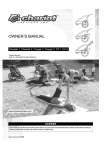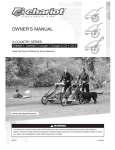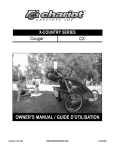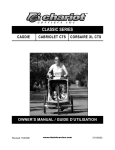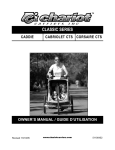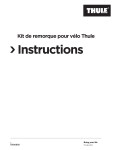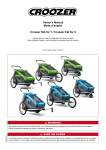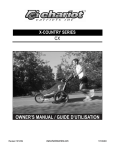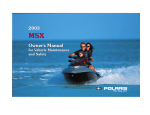Download Chariot Carriers CORSAIRECTS Owner`s manual
Transcript
OWNER’S MANUAL CLASSIC SERIES: Cabriolet, Corsaire XL Keep this Owner’s Manual for future reference. www.chariotcarriers.com ! WARNING You should not use the Chariot child carrier before you have read and understood the contents of this Owner’s Manual. Failure to comply with the instructions contained herein may lead to an otherwise avoidable accident in which you and/or your passenger(s) could suffer serious injury or death. 09/2006 51100453 Chariot Carriers Inc. Bay F - 6810 6th ST SE Calgary AB T2H 2K4 CANADA Table of Contents 1.General Items......................................................................... 3 2.Overview of Components....................................................... 4 Telephone Numbers: 1-403-640-0822 ext 10 1-403-640-0759 (fax) Chariot Carriers Inc. retains all rights to this Owner’s Manual. No text, details, or illustrations from this manual may be either reproduced, distributed, or become the subject of unauthorized use for commercial purposes, nor may they be made available to others. Additional Manuals for using this carrier may be downloaded from www.chariotcarriers.com. Great care has been taken in assembling this manual. Nevertheless, should you discover any errors, we would be grateful if you could bring them to our attention. 3.Safety..................................................................................... 3.1 Explanation of symbols and instructions............................ 3.2 General safety instructions................................................ 3.3 Before each journey........................................................... 3.4 Safety instructions for travelling............................................ 3.5 Safety instructions for maintenance and repairs................ 3.6 Warning against unauthorised modifications...................... 4 4 5 6 6 6 6 4.Description of the carrier......................................................... 7 4.1 Supplied as standard.......................................................... 7 4.2 Erecting and folding the carrier........................................... 7 4.3 Wheel assembly................................................................. 8 4.4 Assembling the reflectors and the safety flag.................... 9 4.5 Legal requirements........................................................... 10 4.6 Attaching the hitcharm....................................................... 11 4.7 Attaching the Axle-Mount ezHitch...................................... 12 4.8 Attaching the carrier........................................................... 13 4.9 Weight distribution and hitcharm load............................... 14 4.10 Suitability of the bicycle used for towing......................... 15 4.11 Travelling......................................................................... 15 4.12 Use as a pull wagon........................................................ 16 4.13 Safety wrist strap (Corsaire only).................................... 16 4.14 Seat and seatbelts.......................................................... 17 4.15 Climate control................................................................ 19 4.16 Adjusting the suspension (Corsaire XL only)................... 21 4.17 Parking brake (Corsaire XL only).................................... 21 5.Parts lists and exploded views.............................................. 23 6. Accessories.......................................................................... 25 7.Service, Care and Storage.................................................... 25 8.Specifications........................................................................ 26 9. Wear and Tear...................................................................... 26 10.Warranty.............................................................................. 28 2 1. General Items Intended Use Congratulations and thank you for purchasing a Chariot Carrier! Use as intended Congratulations on choosing a Classic series CTS Trailer, the key component of the world‘s premiere Child Transport System (CTS). Your new CTS carrier offers superior quality, safety features and comfort. In addition, Chariot CTS Conversion Kits can provide you with the versatility to meet all of your child transportation needs. The CTS Conversion Kits available from your Chariot dealer are the following: • • • • The carrier is intended for use within the performance ranges specified for the carrying of children in daylight hours, on sidewalks, light traffic public roads, and smooth paths. Luggage may also be carried in the storage bags intended for that purpose, provided the children in the carrier are not put at risk. If the child carrier is used in conditions of poor visibility, at dusk or in the hours of darkness, it is highly recommended to be fitted with a safety approved working light set. As part of the recommended use, you should also follow this Owner’s Manual and comply with the prescribed maintenance requirements. Hiking CTS Kit Jogging CTS Kit Strolling CTS Kit XC Skiing CTS Kit (Corsaire only) Use not recommended Any use that goes beyond the above is not recommended. Who is this Manual intended for? This Manual is intended for the purchaser and user of the carrier, who is also responsible for keeping it in proper condition, carrying out maintenance as prescribed and performing repairs. When using this carrier, please also follow the owner’s manual of the bicycle used for towing and the specifications given there regarding the maximum allowable full load for the bicycle. Use not recommended is primarily the conveying of people together with animals, use of this carrier on rough off-road terrain, use for commercial purposes, overloading, excessive speed and improper repair of defects or modifications. The manufacturer is not liable for damages arising from use that is not recommended – this is at the risk of the user. Performance characteristics Cargo load 45 kg / 100 lb, maximum of 2 children Maximum body height of the children, Corsaire XL 117 cm / 46˝ (head or helmet must not protrude above the carrier frame) Maximum body height of the children, Cabriolet 103 cm / 40.5˝ (head or helmet must not protrude above the carrier frame) Top speed 25 km/h / 15 mph Top speed on corners or rough roads walking pace (10 km/h / 6 mph) Permitted hitcharm load (tongue or nose weight, to be ensured by good load distribution, see page 32) 1 - 6 kg / 2.2-13.2lb Permissible rear wheel size on the towing bicycle 26 or 28 inches / 650 C or 700 C 3 2. Overview of Components 3. Safety ! WARN IN G The purpose of this section is to acquaint you with the symbols and safety instructions and make you aware of general dangers that might arise in using the carrier. In addition, here you will get to know about the particular dangers when using the carrier in road traffic, as well as being warned against unauthorised rebuilds or modifications. Here you will find instructions where failure to comply may result in injury or even death to the user and/or the carrier‘s passenger(s). This section, which is entitled »Safety«, is the most important section in this Owner’s Manual. For this reason you need to read through it with particular care and take note of all instructions and safety concerns. Instructions introduced with this symbol indicate possible risk of material damage. Failure to heed this warning may result in material damage. 3.1 Explanation of symbols and instructions In this Owner’s Manual all items relating to safety are provided with a warning. In the designation of the possible hazards, distinctions are drawn based on the severity of the possible harm that may arise. 4 N OTE TIP Here you will find instructions that will make using the product easier for you. 3.2 General safety instructions With regards to the carrier Basics • Never carry any heavy or sharp protruding items in the storage space of the carrier if you are also carrying children at the same time (risk of injury on braking). • Items of luggage should be well secured so that they cannot move around during the journey. Unsecured items of luggage and overloading reduce riding stability and make the carrier more difficult to handle. • The carriers are bicycle carriers and must never be towed behind motorised vehicles. • The carriers must not be carried on the roof of a vehicle, even when folded, as they will get damaged. • At various points on the carrier, self-locking nuts are used. If these have been loosened they must not be reused. Once they have been loosened they lose their original function, and this can lead to unexpected loosening of the screw connection with potentially serious safety consequences. • Do not use the carrier at temperatures below -20°C/-4°F and do not store it at these temperatures. The windows may break. • When folding up or opening the carrier, there is a risk of pinching your hand or fingers. • When the carrier is towed behind a bicycle, the stroller wheels must never be fixed in their use position (wheels down). They may only be carried in their out-of-use position (wheels up). • Remember that on right-hand turns the radius of the turn is restricted. If the rear wheel of the bicycle comes into contact with the hitcharm, there is a risk of the cyclist falling and injury. • Please ensure that when manoeuvring, the carrier is not set at an angle of more than 90° to the bicycle, otherwise the hitch may be damaged. • Reflectors that comply with CPSC regulations shall be visible on the rear of the trailer and on the side of the wheels. • Before using the carrier, please read through the Owner’s Manual carefully. Failure to comply with the safety instructions may result in serious personal injury or death to both the user and/or the occupants of the carrier. • When using the carrier, always comply with local safety and accident prevention regulations, as well as the local Road Traffic Act, all of which may restrict use in some way. • Safe and appropriate use of the carrier is your responsibility. Before using the carrier for the first time, acquaint yourself with its handling characteristics away from public roads and without carrying children. An empty carrier will tip over more easily when going over obstacles with one wheel only than one carrying a load. A fully loaded carrier makes greater demands on the deceleration devices. • Negotiate inclines and corners with the utmost caution and reduce speed when doing so. • Only cyclists who are experienced and strong enough may tow bicycle trailers. If you wish to carry children in the bicycle trailer, you must be 16 years old or over. • Make sure that your bicycle is in good and safe condition. We recommend you have your bicycle regularly serviced by a bicycle retailer. • If you are not sure whether your bicycle is suitable for towing a carrier, please ask your specialist dealer. • General warning: Travelling by bicycle with a child is an activity that is potentially hazardous • We recommend that especially long rear wheel mudguards and rear-view mirrors be fitted to the bicycle that is to tow. • When using this trailer, please also follow the Owner’s Manual of the bicycle used for towing. Find out whether your bicycle is permitted for use in towing bicycle trailers and the permitted overall weight of the bicycle/carrier outfit. • Do not use a kickstand or other parking device to support the bicycle with a carrier attached. Attaching a carrier can change the balance of the bicycle making kickstands ineffective. The bicycle can fall over, damaging it and/or the carrier. With regards to transporting children • Never leave your child unsupervised in the carrier. • Regularly check that your children are appropriately clothed and that they feel comfortable, especially in hot and cold temperatures. • The maximum height of children who may be carried is: 103 cm for the Cabriolet, 117 cm for Corsaire XL • Maximum two children maybe carried. • Make sure that the limbs, clothing and toys of the child do not come into contact with the carrier wheels or the rear wheel of the towing bicycle. • Children carried in the bicycle carrier must be at least 1 year old and be able to sit up without support. • The rider and the children being carried must wear suitable CPSC or CE approved helmets. • If only one child is being carried in a two-seater carrier, then, in the interests of safety, the central sitting position must be used. The carrier might otherwise tip over, with serious consequences for the child. With regards to the children in the carrier • Please remember that the carrier should only be connected or disconnected provided there is no child in the carrier. • When converting with other CTS Conversion Kits, no child should be sitting in the carrier, nor when carrying out maintenance or repair work. • The permitted total cargo load of the carrier is limited to 45 kg. This must never be exceeded. The cargo load is the weight of the children together with any luggage there might be. • Instruct your children not to bounce, rock or lean when riding in the carrier. • Never cycle without closing the two-in-one weather cover otherwise your child may be injured by insects, dirt or rocks thrown up from the road. 5 3.3 Before each ride: • Make sure that the hitcharm is correctly fitted and secured to the carrier, see section 4.6. • Make sure the hitch is firmly attached on the bicycle. A hitch that is not securely attached may work loose from the rear axle and result in losing the carrier, see section 4.7. • Make sure that the hitcharm is correctly coupled and secured to the bicycle, see section 4.8. • Before each journey, check the full function of the warning devices: spoke reflectors, rear reflectors, safety flag, and lights if necessary. • Avoid riding at night. Your ability to see and be seen is greatly reduced. If you must ride at night, use proper lighting and reflectors on your bicycle and wear bright and reflective clothing. Before each journey make sure that the maximum carrier cargo load is not being exceeded and the specified permissible hitcharm load (nose weight) is maintained. 3.4 Safety instructions for cycling with a trailer Basics • Always cycle with care and look well ahead. Avoid applying emergency braking. When emergency braking, there is the risk that the rear wheel of the bicycle may pull to one side and you lose control of the bicycle/carrier vehicle. • Always obey all traffic regulations and use proper hand signals. • Do not assume that you have the right of way. Do not cycle with the carrier in heavy traffic areas such as busy streets, on highways or anywhere it may be unsafe to ride with children. • The maximum permissible speed for towing this carrier is 25 km/h / 15 mph. Take corners/turns at walking pace, as there is a risk of tipping over. • Remember that the steering and braking characteristics of your bicycle are different when towing a carrier. • Always avoid going over obstacles with one wheel of the carrier only, especially on corners – the carrier might tip over, even at walking pace! With regards to carrying the children • Never carry items of luggage on the seat next to your child. • Never carry animals together with your children. • Never carry your children without fastening all the seatbelts in the proper manner, otherwise your child could be seriously or even fatally injured in the event of an accident. Always make sure the seatbelts are properly adjusted to the height of your child. • When travelling faster than walking pace, always use at the very least the mesh component of the two-in-one weather cover. • As the children get in and out, the parking brake must be on to prevent the carrier from accidentally rolling away. With regards to the carrier • Take care when travelling over uneven surfaces. The carrier can overturn if driven with one wheel only across uneven ground, even at very low speed. 6 • Before each journey check the tire pressure. The minimum recommended pressure is 30 psi (2.1 bar) and the maximum is 35 psi (2.5 bar). Even if a higher pressure is permitted for the tires fitted, the Manufacturer recommends that 35 psi (2.5 bar) not be exceeded. Air pressure that is too high considerably reduces the comfort of the children, especially on carriers without suspension. • Do not use compressed air lines (e.g. at service stations). The tires may burst due to the small volume of the tubes. • Never go up or down steps with the carrier. • Before each journey check that the wheels are fully engaged. • Before each journey check that the folding auto-lock disk is fully engaged. • Before each journey check that the spring buttons of the handlebar are fully engaged. 3.5 Safety instructions for maintenance and repairs • The maintenance work specified (see Section 12) is absolutely essential for the long-term safe operation of the carrier. • Only use original spare parts. When replacing safety-related parts, such as the frame, wheels, hitcharm and fabric, only have this carried out by an Authorized Chariot Retailer. • Regularly check all safety-related parts, such as the frame, wheels, hitcharm and fabric, for damage or tearing. At the first sign of damage have the relevant part replaced by your Authorized Chariot Retailer. • Tears in the fabric actually represent a high safety risk. Due to tears in the fabric your child could come into contact with the wheels and/or the road surface. • If you find a tear in the fabric stop using and contact your Authorized Chariot Retailer immediately: the fabric can either be repaired or replaced. • Never try to straighten out bent safety-related parts such as the frame, wheels or hitcharm. Have the relevant part replaced by your Authorized Chariot Retailer. – there is a risk of it cracking and subsequently breaking. • We recommend annual maintenance of the wheels by your Authorized Chariot Dealer. 3.6 Warning against unauthorized modifications and additions • Unauthorized rebuilds or modifications of the carrier are not permitted for reasons of safety and render the warranty invalid. • Installation of a car safety seats, other seats, or seat supports that do not carry the approval of the manufacturer is not permitted. • Do not fit any additional parts, such as a luggage rack, that do not carry the express of the manufacturer. • The carrying of pedal cars, which are attached to the handlebar or some other part of the carrier, is not permitted. 4. Description of the Carrier NOTE: All references to orientation (i.e. left or right) is from the passengers point of view while sitting in the carrier. 4.1 Supplied as standard Pull the W shaped frame rearwards, until the frame is fully uprighted and both right-hand and left-hand auto-lock disks audibly engage. Passenger compartment with two-in-one weather cover folded up, two 20” (51cm) wheels, Hitcharm with Axle-Mount ezHitch (including quick-release skewer), rear and wheel spoke reflectors, and safety flag. 4.2 Erecting and folding the carrier Transport strap lock To be able to erect the passenger compartment, you first need to undo the transport strap lock. You can use the strap lock anytime for holding the carrier fixed in its folded state. Auto-lock disk ! WARN IN G Erecting the carrier With one hand, lift the rear end of the top frame tube upwards, at the same time as holding the bottom part of the rear of the carrier with the other hand. Before each journey make sure that both auto-lock disks are engaged. If this does not happen, the passenger compartment may collapse unintentionally in which your passenger(s) could suffer serious injury or death. 7 Folding the carrier 4.3 Wheel assembly To fold the carrier, pull on both auto-lock disks simultaneously, at the same time as pushing the W shaped frame forwards. Wheel assembly on the Cabriolet TIP The easiest way to assemble the wheel is to lay the carrier on its side. To assemble the wheel, push the axle into the axle socket until it can go no further. As you do this, the spring clip of the axle socket must audibly engage in the axle groove of the wheel. This is how the auto-lock disk is released. NOT E Do not attempt to fold up the passenger compartment without disengaging the auto-lock disk. T IP Folding the carrier with the wheels attached is made easier if you apply the parking brake (see Section 4.17) before you start. Spring clip Test for proper assembly by trying to pull the wheel outwards after assembling. The wheel’s axle should remain locked in the axle socket and cannot be pulled outwards. ! WARN IN G Before each journey make sure that the wheels are securely locked in the axle socket. Failure to do so could result in the lose of the wheels causing an accident in which you and/or your passenger(s) could suffer serious injury or death. To remove the wheel, pull the spring clip out of the hole in the axle socket and pull the wheel out of the axle socket. 8 Wheel assembly on the Corsaire XL 4.4 Assembling the reflectors and safety flag The wheels of the Corsaire XL are equipped with so-called push-button axles. Pressing on the rubber cap in the wheel centre will loosen the retaining balls which lock the axle in the axle socket. The wheels can only be assembled and removed with the plastic cap pushed in. Position a spoke reflector between two outer spokes and an inner spoke in such a way that the inner spoke lies in the guide slot of the reflector. T IP The easiest way to fit the wheel is to lay the carrier on its side. To fit the wheel, press in the rubber cap and insert the wheel axle into the axle socket until it can go no further. Release the rubber cap. By moving the wheel from side to side, check that it is locked in the axle socket and cannot be pulled off. Insert the plastic clip into its slot over the inner spoke and into the hole of the reflector. Secure the clip by tightening it a quarter turn using a screwdriver. ! WA R NING Attach a reflector on each wheel. Before each journey make sure that the wheels are securely locked in the axle socket. Failure to do so could result in the lose of the wheels causing an accident in which you and/or your passenger(s) could suffer serious injury or death. 9 To fasten the rear reflectors you need a Philips screwdriver. 4.5 Legal requirements Remember that at dusk and in the dark, the bicycle and carrier must be equipped with CPSE approved lighting. Rear batterypowered lights for instance are suitable as working lighting. They can be attached to the exposed tube ends on the top right and left on the rear of the carrier, or hooked onto the web tabs located on the upper corners of the back flap. Screw the red reflector into the left grommet on the passenger compartment. Ask your authorized Chariot retailer for suitable lights and the right way to attach them. Push the two safety flag rods together and guide the bottom end of the rod through the cord loop at the back left side of the carrier. Push the end of the rod into the sleeve located at the lower left corner of the passenger compartment until it can go no further. 10 4.6 Attaching the hitcharm The hitcharm should now protrude about 2 cm / 3/4 inch out of the rear side of the VersaWing 2.0, and the rear vertical holes in the VersaWing 2.0 and hitcharm must align with each other. The hitcharm is attached to the CTS Ready Chassis into the left “VersaWing 2.0” bracket. The hitcharm must always be attached into the left-hand side of the carrier (as seen in the direction of travel). The hitcharm must always be attached with both spring buttons pointing upwards. Press down the small button and slide the hitcharm into the VersaWing 2.0 until the large button engages in the VersaWing 2.0 (Figures 1 to 3). Insert the security pin into the rear vertical hole of the VersaWing 2.0 and push it down completely through the hitcharm until the retaining ring is touching the top of the VersaWing 2.0. ! WARN IN G The security pin must always be inserted, in addition to the large spring button in the bicycle hitcharm! A hitcharm that has not been secured properly may come loose during travel resulting in an accident in which you and/or your passenger(s) could suffer serious injury or death. 11 Attaching the Axle-Mount ezHitch to the bicycle The Axle-Mount ezHitch must always be attached to the left-hand side of the bicycle (as seen in the direction of travel). Bicycle with solid axles: The quick-release skewer is not used in this case. Correctly installed hitcharm. ! WA R NING Unscrew the rear wheels left-hand axle nut and the spacer or plane washer. Install the Axle-Mount ezHitch on the axle. The opening for the hitch ball and the vertical hole for the security pin must point forward. Make sure that the hitcharm is correctly attached and secured to the carrier. Any kind of incorrect assembly may lead to loss of the carrier during travel resulting in an accident in which you and/or your passenger(s) could suffer serious injury or death. 4.7 Attaching the Axle-Mount ezHitch Attaching the Axle-Mount ezHitch Your authorized Chariot retailer should fit the Chariot AxleMount ezHitch to your bicycle on delivery of the carrier. In certain special cases, however, you may have to fit it yourself, e.g. after removing the rear wheel or when fitting the Axle-Mount ezHitch to a second bicycle. Assembly for such cases is described below. In all cases, we recommend that you have the Axle-Mount ezHitch fitted by your authorized Chariot retailer. Screw the wheels axle nut and the spacer or plain washer back on and tighten them securely. ! WARN IN G The rear wheels axle nut must be tightened on the axle thread by at least 5 full turns, so that adequate clamping force is ensured. A thread which is too short can lead to accidental loosening of the rear wheel which may lead to an otherwise avoidable accident in which you and/or your passenger(s) could suffer serious injury or death. ! WARN IN G Depending on the hub type, the existing torque support washer for the hub must stay on the frame. Please follow the assembly instructions for the hub and the manufacturer’s torque specifications when fastening the axle nut. Failure to do so may lead to an otherwise avoidable accident in which you and/or your passenger(s) could suffer serious injury or death. Axle-Mount ezHitch and accompanying quick-release skewer. 12 Bicycles with a quick-release skewer Remove the existing quick-release skewer as it is no longer needed. Loosen the nut of the Chariot quick-release skewer. Push the Chariot quick-release skewer through the hitch and then through the axle of the wheel. The opening for the hitch ball and the vertical hole for the security pin must point forward. In order to ensure that the hub is clamped sufficiently in the bicycle‘s chainstay, the quick-release lever must begin gripping as it moves from the open to the middle position, and approaching the closed position you should clearly feel resistance as you tighten. If it is too easy or too difficult to move the quick-release lever, tighten or loosen the lock nut on the other side of the hub to adjust. If you don’t feel confident operating the quick-release skewer, please ask your specialist retailer for assistance. ! WARN IN G Always make sure that the quick-release is correctly attached. An incorrectly tensioned quick-release may lead to an otherwise avoidable accident in which you and/or your passenger(s) could suffer serious injury or death. 4.8 Attaching the carrier Fit the quick-release nut on the right-hand side. Both skewer springs must be located in such a way that the narrow side of each spring points towards the centre of the hub. ! WA R NING From the front, insert the elastomer ball, which is attached to the hitcharm, into the Axle-Mount ezHitch. Pull the hitch ball rearward to the end of the socket in the axle mounted hitch cup. 1 The quick-release nut must be tightened on the axle thread by at least 5 full turns, so that adequate clamping force is ensured. A thread which is too short can lead to accidental loosening of the rear wheel which may lead to an otherwise avoidable accident in which you and/or your passenger(s) could suffer serious injury or death. If in doubt ask your specialist retailer! Close the quick-release lever with the end of the lever pointing upwards. In this position there is enough space to insert the security pin. 2 13 Push the security pin from the top through both holes of the Axle-Mount ezHitch. Finally, always attach the hitch’s back-up safety strap around the bicycle frame. To do this, from above, put the hitch back-up safety strap around the chain stay, and attach the hook of the hitch backup safety strap to the hitcharm D-ring located on the underside of the hitcharm. 6 3 Secure the pin by pulling the hole of the rubber tab over the protruding end of the pin. ! WARN IN G Always attach the hitch’s back-up safety strap in the manner described above. It serves as additional protection against losing the carrier during operation. Do not use the Bicycle Trailer if you cannot attach the hitch’s back-up safety strap around your bicycle frame for any reason! Failure to install the hitch‘s back up safety strap may lead to an otherwise avoidable accident in which you and/or your passenger(s) could suffer serious injury or death. 4 4.9 Weight distribution and hitcharm load (tongue or nose weight) on the hitch The exact position of the seat in the Chariot has been specially chosen so as to give optimum weight distribution if there are only children sitting in the carrier. The only other factor in weight distribution is the weight of luggage items. The storage compartment is intended for the carrying of luggage items. The carrying of luggage items next to the child on the seat is prohibited. We would also urge against carrying luggage items in the foot space. Checking of the hitcharm load (tongue or nose weight) is important if you want to carry a heavy load in the storage compartment along with a light child, or if you are using your Chariot as a Bicycle Trailer. 5 14 The hitcharm load (tongue or nose weight) on the carrier hitch needs to be 1 - 6 kg / 2.2 – 13.2 lb for safe road handling. The hitcharm load (tongue or nose weight) is the weight that you lift on the hitch when the carrier is loaded up. If you are not confident about estimating the hitcharm load (tongue or nose weight), use a bathroom scale to help you: 1. Put the bathroom scales next to the hitcharm of the loaded carrier. 2. Stand on the scales and note your own weight. 3. Lift up the hitcharm at the hitch to around 30 cm/12 inches above the ground. ! WARN IN G When used as a Bicycle Trailer, the stroller wheels must never be installed in their use position (wheels down). They may only be carried in their out-of-use position (wheels up) Failure to do so may lead to an otherwise avoidable accident in which you and/or your passenger(s) could suffer serious injury or death . For a description of the positions of the stroller wheels, see Section 7. The weight as displayed should now be 1 - 6 kg/2.2 – 13.2 lb above your own weight. 4.10 Suitability of the bicycle used for towing Always make sure you follow the manufacturer’s specifications in the owner’s manual of the bicycle used for towing, where the suitability specifications of the bicycle are to be found. Example 1: If the manufacturer states, this bicycle is suitable for pulling an unbraked trailer of overall weight 40 kg, then you may add a maximum load of 30 kg, since the carrier itself weighs approximately 11 kg/24 lb (e.g. Cabriolet). Example 2: If the manufacturer states, the permissible bicycle full load of 120 kg/ 265 lb may not be exceeded, then please note that the permissible full load may also not be exceeded if you attach a trailer. In order to determine the cargo load, you need to subtract the weight of the bicycle, your own weight and the carrier unloaded weight from the permissible full load. For instance, if the bicycle weighs 15 kg/ 33 lb and the cyclist weighs 72 kg/ 159 lb, then a maximum of 22 kg/ 49 lb additional cargo load may be carried (120 - 15 - 72 - 11 = 22)/(265 – 33 – 159 – 24 = 49). You will find the weight specifications for your carrier in Section 11 “Specifications”. If there is nothing specified in the owner’s manual of your bicycle regarding towing a trailer, this does not mean that there are no limitations. In such a case, always ask your authorized Chariot retailer. Wrong!!! Correct assembly of the stroller wheels for carrying them out-of-use when used as a Bicycle Trailer. Pay attention to the following when travelling: Follow all safety instructions at the beginning of this section and the general safety instructions at the beginning of the Owner’s Manual. ! WARN IN G When turning round or manoeuvring the vehicle, the angle between the towing bicycle and the carrier must not exceed 90°. The hitch ball may get damaged (overstretched) and lose its stiffness which may lead to an otherwise avoidable accident in which you and/or your passengers could suffer serious injury or death. 4.11 Travelling Please ensure the following before each journey: Follow all safety instructions at the beginning of this section and the general safety instructions at the beginning of the Owner’s Manual. 15 4.12 Use as a pull wagon On short stretches and level surfaces, the carrier may be used as a pull wagon. For this, insert the hitcharm rotated through 90° counterclockwise in the left-hand (in direction of travel) VersaWing 2.0 (the same wing as the hitcharm is used for trailering). The front end of the hitcharm must point upwards. Push the hitcharm in until the spring buttons, which is now on the outside side, come up against the VersaWing 2.0. Then press the smaller button in and slide the hitcharm into the VersaWing 2.0 until the large spring button audibly engages. ! WARN IN G Any assembly of the hitcharm other than the one described is not permitted. Any kind of incorrect assembly may lead to loss of the carrier during travel resulting in an accident in which you and/or your passenger(s) could suffer serious injury or death. 4.13 Safety wrist strap (Corsaire only) On the rear left upper frame tube, as seen in the direction of travel, there is the safety wrist strap, which is required to secure the carrier to the wrist when using it as a Jogging Stroller or Stroller. In all other carrier uses, this wrist strap should be stored safely in the storage compartment at the rear of the carrier. On this type of assembly, engagement of the spring button is not visible, however you should be able to see the small spring button returned to its normal “out” position. Insert the security pin through the horizontal hole at the back of the VersaWing 2.0. ! WA R NING Make sure the spring button engages correctly. Before use, ensure that the hitcharm is securely locked by giving it a good forward pull. If this is not the case, the hitcharm might work loose during travel resulting in an accident in which your passenger(s) could suffer serious injury or death. ! ! WA R NING Only park the carrier on flat surfaces and secure it with the parking brake, otherwise the carrier could role away in which your passenger(s) could suffer serious injury or death. 16 WARN IN G Always make sure the safety wrist strap is safely stored in the storage compartment when it is not in use. If this is not done it could get caught in the wheel spokes, and this may result in an accident in which you and/or your passenger(s) could suffer serious injury or death. 4.14 Seat and seatbelts padded shoulder harness buckle of the shoulder harness (under tab) lap belt crotch harness To fasten the child into the carrier, proceed as follows: Adjusting the padded shoulder harness 1. The shoulder harness should always stay fastened to the crotch belt by their lower buckle. 2. Undo both top buckles releasing the padded shoulder harness from the carrier‘s back rest. Pull the shoulder harness towards the front. 3. Open the waist belt. 4. Place the child on the seat. 5. Make sure that the crotch belt is between the child’s legs. 6. The shoulder harness’s corresponding two buckles are attached to vertical straps. Slide both upper buckles long these vertical straps until they are directly above the shoulders of the child. 7. Draw the shoulder harness upwards over the child’s shoulders and click both of the upper buckles into their respective buckles on the vertical straps. Make sure that you do not pinch the child’s neck with the buckles. 8. Once again make sure that the crotch belt is between the child’s legs. 9. The tension can be adjusted in all three joined straps. The shoulder harness can be adjusted to fit correctly by pulling tight or loosening the loose ends of the upper securing straps to equal degrees. The loose end of the crotch belt can be pulled tight or loosened as well. 10. Adjust the shoulder harness and crotch belt so that all belts are tight and the lower end of the padded shoulder harness with the “Chariot” logo is level with the child’s lower chest region. 11. Fasten the waist belt. The waist belt must be on the outside of the crotch belt. 12. On each side of the waist belt buckle, the waist belt has a loose belt end for adjusting the tension. Adjust the waist belt until it is tight and the buckle is centered in front of the crotch belt. 13. Finally check that all belts are tight. Avoid putting too much pressure on the child’s body. 14. Make sure that the padded shoulder harness’s belt position is correctly adjusted, as described below. To achieve the correct size of the padded shoulder harness, sleeve through or remove the shoulder belts with the plastic buckle through these adjustment loops, as indicated below: XS: Do not sleeve through any adjustment loops; thus unsleeve the shoulder belts from all loops. (without illustration). S: Only sleeve through the lowest webbing loop. When sized for XS and S, the un-used, upper sections of the shoulder harness go loose over the children‘s shoulders. Smooth them down their back for comfort. 17 TIP M: Sleeve through both webbing loops. This is the default setting. Always sleeve or unsleeve the shoulder belts as described above equally on both sides of the padded shoulder harness, otherwise the shoulder harness will not sit properly, and correct fit of the seatbelts is not possible. TIP Depending on manufacturing tolerance, the above mentioned loops may turn out to be too narrow to pull the buckles through them. To make unthreading easier in this situation, you can unthread the buckles and then rethread them as in the illustration below. L: Sleeve through both webbing loops and the top cord loop. ! WARN IN G Always make sure you thread the belt through correctly (see illustration above). If this is not the case, the belt could slip out of the buckle resulting in the seatbelt failing in which your passenger(s) could suffer serious injury or death. Whenever you thread the belt through again, always give it a good pull to check that it cannot be pulled out of the buckle. ! WARN IN G Always make sure the seatbelts are correctly fastened around your child and are correctly adjusted to the height of your child. If this is not the case, your passenger(s) could suffer serious injury or death in the event of an accident. ! WARN IN G Before each journey check all buckles. If this is not done, the belt system may fail resulting in an accident in which your passenger(s) could suffer serious injury or death. Comparison of different adjustments of the padded shoulder harness for children of different heights. 18 If only one child is being carried, the child must be placed in the centre of the seat. Strap the child in as follows: 4.15 Climate control 1. Fasten one of the shoulder harnesses to the middle two vertical straps buckles on the backrest. 2. Use the two middle waist belts. 3. Use the additional crotch belt located in the middle of the seat. 4. The second shoulder harness, the two outer crotch belts, and the outer two waist belts are not used. 5. Adjust the belts as previously described. All models are equipped with the Chariot two-in-one weather cover, which consists of a plastic window that can be rolled up with mesh beneath it. ! The two-in-one weather cover WA R NING Always make sure you thread the belt through correctly (see illustration above). If this is not the case, the belt could slip out of the buckle resulting in the seatbelt failing in which your passenger(s) could suffer serious injury or death. Whenever you thread the belt through again, always give it a good pull to check that it cannot be pulled out of the buckle. ! WA R NING Always make sure the seatbelts are correctly fastened around your child and are correctly adjusted to the height of your child. If this is not the case, your passenger(s) could suffer serious injury or death in the event of an accident. ! WA R NING Before each journey check all buckles. If this is not done, the belt system may fail resulting in an accident in which your passenger(s) could suffer serious injury or death. 19 The two-in-one weather cover is attached to the bottom of the front of the passenger compartment with two buckles. For better ventilation during high temperatures, the rear flap can be opened, rolled up and secured in place by two elastic loops. There is an insect mesh located under the rear flap and attached at the bottom by two velcro fasteners. This should be closed if the rear flap is open. Always make sure that the two-in-one weather cover is securely attached at the front. T IP Make sure that the front section of the two-in-one weather cover is pulled over the front ends of the passenger compartment to help ensure that no water can penetrate the interior. The rear flap can also be used at the front as a sunscreen. For this, it has to be sleeved under the rolled up two-in-one weather cover towards the front. On the forward sides of the passenger compartment at this point there are velcro fasteners. Open these fasteners and connect them to the velcro fasteners on the rear flap. The two-in-one weather cover can also be closed with the sunscreen in place. Rear flap The rear flap is attached at the bottom by two velcro fasteners. 20 4.17 Parking brake (Corsaire XL only) Front side air vent For additional ventilation of the interior, the carriers are equipped with a side air vent to the front of each side window. It can be opened either fully or partly from the inside by means of a fabric flap. Installing the parking brake Use an 13 mm wrench to loosen the securing nut on the short lever in the centre of the brake rigging. 4.16 Adjusting the suspension (Corsaire XL only) The Corsaire XL is equipped with Chariot‘s Adjustable Suspension (CAS) system. Lay the carrier on its roof. To prevent damage, make sure you have a suitable surface to do this on. Unscrew the nuts from the two bolts protruding from the bottom at the sides towards the rear. After loosening the knob, it is possible to move the clamp that surrounds both leaf springs. The more this clamp is moved in the direction of the wheel axle, the stiffer the suspension becomes (see the weight scale on the top spring). The weight indications on the scale are calculated from the weight of the child(ren) and cargo (ie. You do not need to add the weight of the carrier). Now guide the bolt on the brake pivoting mechanism through the hole in the centre at the rear of the carrier, and the two side bolts on the carrier through their respective holes in the two long brake bars. Make sure that you position the brake as illustrated. The weight indications on the scale relate first and foremost to use as a Bicycle Trailer. For other uses it may be a good idea to set the suspension softer. If you discover that when riding over bumps the suspension can be felt and likely heard, then the suspension is set too soft and you need to move the knob rearwards. NOT E Make sure that you retighten the knobs once you have adjusted the clamp. 21 Screw the two self-locking nuts onto the two side bolts. Screw them on so that the end of the bolt protrudes through the nut, but not so tight that the brake cannot move. To apply the brake, the operating lever must be moved completely to the left. Once you have moved it past the middle of the carrier, the operating lever should automatically overcenter into the left and closed position. Now both brake arms press on the tires, thereby stopping the wheels from turning. Inside the carrier, screw the third self-locking nut onto the bolt of the brake pivoting mechanism. ! WA R NING Always make sure that the self-locking nuts are only screwed onto the bolts until the end of the bolt protrudes through the nut. If this does not happen, the self-locking nuts cannot fulfil their self-locking function, and this may result in the brake working loose resulting in an accident in which your passenger(s) could suffer serious injury or death. Operating the parking brake When the parking brake is released the operating lever points to the right and should be resting up against the lower rear edge of the carrier (seen in the direction of travel). 22 ! WARN IN G Depending on the tire pressure, the brake operating lever can snap with some force into its closed position. Be careful when doing so as you risk getting pinched and injured! 5. Parts lists and exploded views Parts List Cabriolet A B C D E F G H I J K L M N O P Q R S T U V W X Y Part # Part 40100105 40100106 41100205 40100403 40100723/4 40100601 41100453 40101109 50103033/4 40101516 40101517 40202002 41101281 41101282 41100803 41102128 32100131 50203031 50101801 50101729 50101307 30100137 41101725 41101802 41100628 50101904 50101906 31100117 Upper Frame - Left Upper Frame – Right Lower Frame Back Frame Back Tube Seat Frame U-Frame Hitch Arm & Securing Pin Strap Axle Mounted Hitch & QR Skewer Versa Wing 2.0 - Left Versa Wing 2.0 - Right Backup Safety Strap Autolock Back Bracket – Left Autolock Back Bracket – Right Support Hoop Seat Riser Seat Shoulder Harness Safety Flag Spoked Wheel Clevis Axle with Wave Washer & Retaining Ring Fabric Body Hollow Axle Hollow Plug Glide (Handle Bar Sleeve) Seat Anchor Tube Assembly Reflector - Red (not shown) Reflector - orange (not shown) All Season Weather Cover (not shown) Quantity 1 1 1 1 2 1 1 1 1 1 1 1 2 2 1 2 1 2 1 2 2 1 1 2 1 1 2 1 23 Parts List Corsaire XL A B C D E F G H I J K L M N O P Q R S T U V W X Y 24 Part # Part 40100109 40100110 41100206 40100405 40100723/4 40100601 41100453 41101105 50103033/4 40101516 40101517 40202002 41101281 41101282 41100808 41102128 32300708 50203031 50101801 50101729 50101305 30100225 41101701 50101815 41100628 50101904 50101906 31100214 40101904 Upper Frame - Left Upper Frame – Right Lower Frame Back Frame Back Tube Seat Frame U-Frame Hitch Arm & Securing Pin Strap Axle Mounted Hitch & QR Skewer Versa Wing 2.0 - Left Versa Wing 2.0 - Right Backup Safety Strap Autolock Back Bracket - Left Autolock Back Bracket - Right Support Hoop Seat Riser Seat Shoulder Harness Safety Flag Spoked Wheel Clevis Axle Fabric Body Suspension tube Hollow Plug Glide (Handle Bar Sleeve) Seat Anchor Tube Assembly Reflector - Red (not shown) Reflector - orange (not shown) All Season Weather Cover (not shown) Parking Brake (not shown) Quantity 1 1 1 1 2 1 1 1 1 1 1 1 2 2 1 2 1 2 1 2 2 1 1 2 1 1 2 1 1 6. Accessories Fabric Axle-Mount ez-Hitch for additional bike Baby Bivy Baby Supporter Bunting Bag Classic Cargo Kit Hydration Kit Handlebar Bag Infant Sling Jogging Brake Kit 1.0 Rain Cover Side Fenders 2.0 Storage Cover Travel Bag 2 Check the fabric regularly for signs of damage (e.g. tears). 7. Service, Care and Storage Contact your authorized Chariot retailer immediately if you find a tear in the fabric. The fabric can be repaired or replaced. ! WARN IN G Tears in the fabric actually represent a high safety risk. Due to tears in the fabric, your child could come into contact with the wheels or the road surface and be seriously injured. Clean the fabric regularly with domestic soap or a mild cleansing agent and warm water. Never use thinners or cleaning solvent. Hitcharm Storage Check the hitcharm regularly for signs of damage (e.g. cracks). Store your Chariot CTS in a dry and well-ventilated place. Before storing your carrier, it should be dry to prevent the growth of mould and the formation of mildew. Expose your carrier as little as possible to direct sunlight to prevent fabric colours from fading. Do not store the Bicycle Trailer coupled to the bicycle over a long period of time. ! WA R NING If there is any kind of damage whatsoever to the hitcharm, then it must be replaced so as to prevent breakage which could result in an accident in which your passenger(s) could suffer serious injury or death. Wheels Clean the wheel axles, the retaining balls and the push-button pin regularly. Apply some grease or oil to the retaining balls and push-button pin. N OTE As well as rubber, tires contain many chemical substances which improve their physical characteristics. In unfavourable circumstances, these substances may lead to staining of the transparent side and front windows on the carrier. For this reason, always store wheels in such a way that they do not come into contact with these windows. General Maintenance Look after your carrier. All painted, chrome or galvanised parts (including screw connectors) should be regularly cleaned and protected using standard products for this purpose. Ask your specialist retailer about suitable products for protecting your carrier. ! WA R NING If the retaining balls and push-button pin are not regularly maintained, they may lose their securing function. This could result could result in the loss of the wheels causing an accident in which you and/or your passenger(s) could suffer serious injury or death. Have the wheels (tires, rims, tension of spokes, axle bearing) checked by your authorized Chariot retailer at least once every year. Clean the wheels regularly and give them a protective wax, particularly just before the onset of Winter. 25 8. Specifications L x W x H, without hitcharm, Cabriolet (39˝ x 32˝ x 36˝) L x W x H, without hitcharm, Corsaire XL (39˝ x 32˝ x 38.5˝) L x W x H, folded up, Cabriolet L x W x H, folded up, Corsaire XL Maintenance and care of bicycle trailers and jogging strollers: 100 x 82 x 92 cm 101 x 82 x 98 cm (38.5˝ x 31˝ x 11˝) 98 x 78 x 27 cm (41˝ x 32˝ x 14.5˝) 104 x 82 x 37 cm Unladen weight of the Ready Chassis Cabriolet Corsaire XL 11,1 kg / 24,4 lb 13,4 kg / 29,5 lb Cargo load 45 kg / 100 lb Wheel of the Carriers 20˝ (51 cm) Irrespective of • Type of use • Intensity of use • Care and maintenance functional-related wear occurs in bicycle trailers or jogging strollers in the components and parts listed in the following table. Reaching the wear limit very much depends on how well the users have looked after and maintained the product as well as the particular type and intensity of use such as: • Mileage • Loading of: Passengers Baggage • Type of ride: Degree of acceleration and braking 9. Wear and Tear • Fast cornering Our products have components or parts which are also subject to natural wear and tear arising from normal use, depending very much on the type and degree of use and also how well the individual product has been serviced and maintained. • Effects of the weather: UV rays Humidity Dirt Temperature Salty air Contact with salt water Roads gritted with salt In particular where there has been a lot of use (day in day out and in all kinds of weather), individual parts or components can reach their wear limit before the warranty has expired. Just because a product has become prematurely worn because of use, it does not generally mean the product is defective. For your information we have therefore listed in the following table the important parts affected by wear and tear, and have named typical contributing factors relating to use, which may considerably influence wear limit. • Storage • Level of maintenance: Service intervals Means of maintenance Storage Servicing and inspection work Please look at the following table: ‘Wear factors’. You can see from this table which factors particularly affect the wear and tear on individual parts. 26 27 10. Warranty 28




























